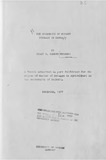| dc.description.abstract | This thesis analyses the economic and technical factors that influence the amount of potato stored and the type of potato storage facilities
currently in use at farm-level in Kenya.
The thesis is based on survey carried out between February and June, 1977 in Kibirichia location and results of potato storage trials carried out at the same period, in Molo, Ngecha in Kiambu and in Kibirichia in Meru District by German Agricultural
Team, International Potato Centre and the author.
Chapter I describes the importance of potatoes in Kenya. Potatoes are compared to maize as staple food stuffs. The calorie production per hectare per year of^ potatoes is slightly more than that of maize. Since potatoes are highly perishable, they require elaborate storage facilities. Little is known about the storage systems in this country hence the purpose of this study. Chapter II describes the specific objectives of, and the main questions
to be answered by the study.
1
The main hypotheses and the methodology are described in chapter III. A random sample of 71 farmers were interviewed in Kibirichia and potato storage trials set in Molo, Ngecha and
Kibirichia.
XX
Results of the research findings are presented in chapters 4 and 5. Potatoes stored for sale accounts for 38,8% of the total potato harvested, compared to 31.8% potato sold immediately after harvest and 30% are consumed. Farmers store potatoes for a maximum period of three months.
The main factors that determine the quantity stored is the quantity harvested, and quantity sold directly after harvest; storage capacity given.
The quantity harvested explains the variation in quantity stored by 72.9%. This is the major determinant*
•
Potato acreage in the farms, quantity sold and quantity consumed are inversely related to the quantity stored.
88.7% of the stores in Kiblrichia are built separate from other farm buildings (Houselike). Granaries, pits and stores attached to dwelling houses were other types of stores commonly used.
More than 65% of the sample stores were built of earth floors, corrugated iron sheets roofs and timber walls, with some form of air ventilation.
Other structural designs include, mud and stone walls; concrete and timber raised floors; and
T
xix
Some of (i>
(ii)
(iii)
<iv)
(v)
(vi)
(vii)
(viii)
the hypotheses tested were:
The constructional materials of potato stores depend on their sizes;
The quantity stored Is a function of surplus potato production.
The quantity stored is a function of the expected losses during storage time.
The losses in potato weight during storage depend on temperatures and relative humidity
irrespective of geographical location.
*
The potato storage temperature range is 5°C and the relative humidity range is 20% in Kenya.
The constructional materials of the established
potato stores depend on the local mater” rials available and not on the climatical or technical requirements of the potato storage.
I
Destoring period depend on the price movement
in the local market.
That the price during the harvesting period is less than and/or equal to price during
4
the selling period minus the storage cost.
grass thatched roofs; The average investment cost of a store 5.57m long, 3.74m wide and 2.4m in height and of a storage capacity of 37 tons was K.Shs. 2,400.00.
Farmers do not use sprout suppressant chemicals.
A few farmers on the lower zone of Kibirichi used tuber moth-killing chemicals. All farmers in Kibirichia store potatoes in bulk with some form of insulation.
The potato storage temperatures in Molo range from 11°C to 15°C, in Kibirichia from 15°C 17°C and in Ngecha from 17°C to 19°C while the relative humidity in Molo range from 72% to 96% in Kibirichia from 65% to 80% and in Ngecha from 40% to 85%.
*
This shows that potatoes store best in Molo followed by Kibirichia and finally by Ngecha.
In terms of investment strategy, the * stores used by the farmers are recommended instead of the improved trial granaries or the forced ventilated store built by Schuelter company.
xxii
It is recommended that potato marketing should be carried out co-operatively so that trading margins to the farmers are increased. This would bring about institutional pricing system, which would operate to the benefit of the farmer and the consumer. It is felt that spectral analysis should be carried out to find out whether the factors that influence prices in different markets in Kenya are the same or not. | |

